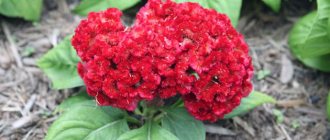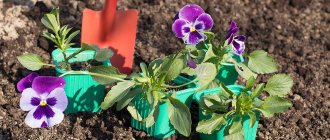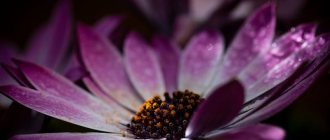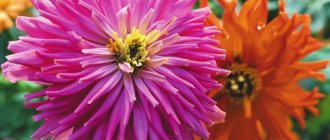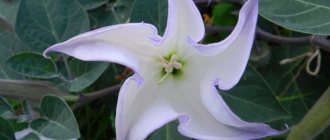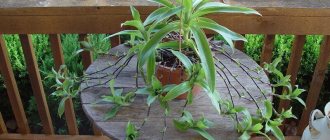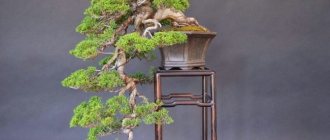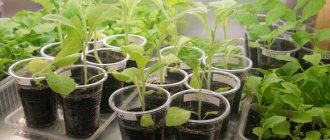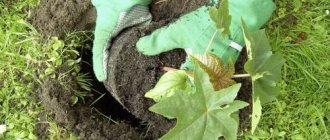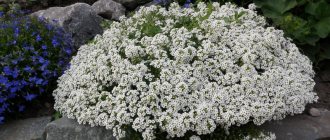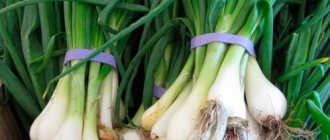Glorified by S. Rotaru and the author of the words M. Shabrov, mountain lavender brought this flower traits of romance and quiet sadness. Small lilac flowers have always been valued less than the emitted aromas of lavender and its beneficial properties. However, today this plant can be easily grown in your garden, near your home or even on your windowsill. In return, you will receive everything - an excellent home decoration, an excellent, healthy addition to tea, and you will be able to enjoy the fresh aromas of the meadow throughout almost the entire summer and part of autumn.
Dear readers! For you, we have created communities on social networks in which useful articles and interesting ideas are published several times a day! Subscribe and receive useful content in a convenient format!
Lavender - a very low-maintenance plant. To some extent, it easily grows on its own. And in this article we will tell you which lavender you can choose (and there are many varieties), how to grow good seedlings and what to do to make this plant a permanent guest on your site.
How to determine the time of sowing Lavender?
Although Lavender is a cold-resistant plant, its seeds do not have any good germination rates. Therefore, under the slightest unfavorable factors, they may emerge sparingly or not appear from the ground at all.
Therefore, it is best to grow Lavender in Russia first with seedlings, and then, when there is enough light and quite warm outside, transfer it to a permanent place.
If we speak on average within the country, then seedlings should be planted around the end of February. And transplanting to open ground should not begin until May.
Instructions for sowing seedlings
Every gardener, even a beginner, can easily plant seeds for seedlings. There are no difficulties or secrets here; however, there are a number of recommendations, the observance of which will allow you to obtain strong and healthy young shoots, ready for transplanting into open ground.
Selection and preparation of seed material
High-quality seeds are the key to good plants. That is why it is recommended to buy them in trusted gardening stores or in markets from other gardeners.
When purchasing, first of all, you need to pay attention to the integrity of the packaging: there should be no dents or damage on it. It also indicates a description of the variety, recommendations for planting and care, the expiration date of the seed - the gardener should also pay attention to all this.
The seeds themselves should be whole, approximately equal in size, and not have dark or light spots on the surface or smell of rot. If the seed is too cheap compared to competitors, it is most likely of poor quality. It is not recommended to take it.
The best way is to collect lavender seeds yourself. Store them in a dark and dry place in sealed, moisture-proof packaging.
Where to sow the seeds
It is recommended to plant lavender seedlings in plastic, wooden or other containers 7-10 centimeters deep. In addition, it is not at all necessary to sow seeds in a common container; you can also use individual cups, cassettes or peat tablets.
The main thing is that the container is drained. To do this, make a small hole at the bottom to drain excess liquid.
Soil selection and preparation
A ready-made mixture is suitable for lavender seedlings - a universal soil for indoor plants. It can be easily purchased at any gardening store. Another option is to make your own substrate. For this purpose, mix the following components (note: 1 part - 1 tablespoon):
- soil from the garden - 12 parts;
- humus - 8 parts;
- sand of any size - 4 parts.
Before planting seeds, the soil, purchased or homemade, must be disinfected.
To do this, it is recommended to use the steaming method: spread the soil on a cloth, place it in a colander and keep it over steam for half an hour, stirring regularly. In addition, biofungicides must be poured into the soil. They are able to restore the natural microflora of the soil. For this purpose, Fitosporin or Trichodermin are used.
Sowing
Proper sowing of lavender seeds for seedlings is a guarantee that the young ones will be strong and healthy and will calmly tolerate replanting in open ground. Sow in several steps:
- Prepare the container. Make a drainage hole in it at the bottom.
- Place a small layer of coarse sand or perlite on the bottom. It will act as drainage and help remove excess moisture. The thickness of the layer is 1-1.5 centimeters.
- I fill in the soil mixture, leaving 2-3 centimeters on top.
- Spray the surface with warm water at room temperature from a spray bottle.
- Place the seeds one at a time, keeping a distance between them of approximately 1.5-2 centimeters.
- Sprinkle the seeds on top with soil.
- Spray the surface with warm water at room temperature from a spray bottle.
- Cover with a lid or plastic wrap to create a greenhouse effect.
- Place containers with seeds in a warm place. For seedlings, it is desirable that the temperature be around 18-20°C.
If several types of plants and crops are planted at the same time, it is recommended to label each container, indicate the variety and date of planting.
How to prepare planting material for sowing?
Along with the obligatory calcination of the soil, it would not be superfluous to soak the seeds before planting in a weak solution of potassium permanganate. This is a standard step for any seedling, but it is always effective.
However, the most important point for Lavender is different - the mandatory stratification or hardening of the seeds.
Stratification of Lavender seeds
Stratification of Lavender seeds involves keeping the seed at low temperatures (+2-4°C). This is most often done in the refrigerator and thus creates an imitation of natural conditions when the seeds overwinter under a layer of snow and melt water.
ATTENTION! The stratification of Lavender seeds cannot be canceled in any way. Otherwise, the plant will either not sprout at all, or will grow weak and sick.
There is a reason why you should put seeds in the refrigerator. There are several ways:
- Lavender seeds are placed on one cotton pad soaked in water, after which they must be covered with another damp cotton pad. All this is placed in some container, covered with a bag and left in the refrigerator. Periodically, the seeds should be removed, checked and the discs re-wetted with water.
- The same can be done on some piece of fabric. It is divided in half: the seeds are laid out on one part, and they are covered with the other like a blanket. Everything is also wetted, placed in a cold place and also checked periodically.
- The easiest way is to take sand, moisten it with water, mix the seeds in it and leave it in a closed container in the refrigerator. When the time comes for seedlings, this entire mixture of sand and seeds can be scattered into the prepared container without separating.
Stratification takes a long time: ideally up to 6 weeks, but at least 3-4 weeks. This must be taken into account in order to comply with all deadlines for working with seedlings. If you plant Lavender at the beginning of March, then you need to stratify the seeds already in the middle or end of January.
Lavender varieties. Which one is better to choose?
At least 30 species of Lavender grow in the wild. But only some of them enjoy enduring popularity in cultural breeding.
Voznesenskaya 34
It is resistant to frost, but most often the variety is chosen for use in folk medicine. It is believed that this Lavender has the most beneficial properties.
Delight
A variety resistant to cold and drought, the main feature of which is the pleasant aromas it emits.
Southerner
The variety is the fruit of the work of domestic gardeners. The southerner needs stratification, but she feels great in most of Russia in open areas.
English
This variety can grow in one place for up to 20 years! It is distinguished by purple flowers with white down – from a distance the color appears bluish because of this. This Lavender is not afraid of frost.
Narrow-leaved
Frost-resistant variety, very suitable for growing throughout the middle zone, in the Urals, and Siberia. It is characterized by very long shoots (up to 1 m), almost completely covered with purple flowers.
Fragrant Butterfly
An interesting dwarf variety, the main feature of which can be called inflorescences - they are dark purple or lilac. And sometimes both colors are present on one plant at once.
Purple Haze
A neat variety, barely exceeding 20 cm in height. It has strong immunity to pests and diseases. But he loves the sun very much.
General information about the plant
Lavender is an excellent representative of the Lamiaceae family. Reproduction of the plant is possible in different ways (stem layering, cuttings, dividing the bush, sowing before winter), but growing from seeds by seedlings is especially interesting!
By the way! Lavender fits perfectly into the composition of an alpine hill or rock garden. Looks very good along the paths on the site.
The plant is warm and sun-loving, so it grows safely in the southern regions. In colder regions (for example, in the middle zone), cultivation is possible, but it is best to plant angustifolia or English lavender (shown in the photo below), this is the most winter-hardy variety.
The smell of the plant cannot be confused with any other - spicy, rich, elegant, pleasant. Very often, the aroma of the flower is used for aromatherapy, which uplifts and soothes. The flowers of the plant are used to make a delicious tea that has a calming and relaxing effect.
By the way! Lavender blooms the next year after sowing.
Why is it worth planting a crop on your site? The plant is beautiful, has a wonderful aroma, you can make medicinal teas from the flowers or simply make sachets and use them at home for aromatherapy; lavender is an excellent honey plant, so it can attract beneficial insects to your garden.
When to sow Lavender for seedlings in 2021 according to the lunar calendar?
An experienced person, when growing seedlings, will try to take into account a lot: the weather, climate, his capabilities, but will also look at the lunar calendar.
Favorable days for sowing Lavender in 2021, depending on the month
Lavender is usually planted for growing seedlings in February and March. But there are those who can start seeds in January.
Favorable dates for working with lavender seeds in 2021 will be:
- In January : 16, 17, 18, 19, 20, 21, 22, 23, 24, 25, 26, 27.
- In February : 12, 13, 14, 15, 16, 17, 18, 19, 20, 21, 22, 23, 24, 2526.
- In March : 14, 15, 16, 17, 18, 19, 20, 21,22, 23, 24, 25, 26,27.
- In April : 13, 14, 15, 16, 17, 18, 19, 20, 21, 22, 23, 24, 25, 26.
- In May : 12, 13, 14, 15, 16, 17, 18, 19, 20, 21, 22, 23, 24, 25.
Bad days for sowing seedlings in 2021
Unlucky days for working with seedlings for 2021:
- In January : January 13 - full moon, January 28 - new moon, Aquarius days - 14, 15.
- In February : February 11 – full moon, February 27 – new moon.
- In March : March 13 – full moon, March 28 – new moon.
- In April : April 12 – full moon, April 27 – new moon.
- In May : May 11 – full moon, May 26 – new moon.
When to plant depending on the region?
Of course, there are also differences in the activities for growing seedlings in different regions of Russia. For example, it is known that any variety of this plant can grow in the middle zone. But it is better to give preference to frost-resistant ones: English Lavender, Narrow-leaved Lavender, etc.
In Moscow and Moscow region
In the Moscow region, lavender usually begins to be planted in the second half of February. The plant is ready for transplanting in early or mid-May.
In the middle lane
About the same can be said about the entire middle zone. Seedlings - mainly in February, transplanting - by mid-May.
In the Urals
The Ural region is well suited for growing lavender. But it is better to plant seedlings at the very end of February or even the beginning of March. Then the transplant will have to take place at the end of May, when the weather should definitely not present any surprises.
In Siberia
In Siberia, it is also worth slightly shifting the timing for growing seedlings to the beginning of March, and transplanting them into open areas to coincide with the end of spring.
In the Leningrad region
As in the entire central zone, and in the Leningrad region and in the north-west of the country, lavender is sown at the end of February and replanted in the second half of May.
Transplanting seedlings into open ground
Around the end of May, lavender can be transplanted into open ground. Loose soils are ideal for it. It is ideal to use sandy or loamy soils. If the soil is acidic, then wood ash or dolomite flour is added to it.
It is recommended to plant lavender in a sunny place in the garden so that it is not in the shade from the house or other taller plants
Planting in open ground is performed as follows:
- choose a place;
- prepare the seedlings, transfer the cups to the garden, water the seedlings.
- Use a pen or wooden stick to make holes at a distance of 30 centimeters;
- using the transshipment method, without destroying the soil around the sprout, replant the lavender;
- Compact the soil around the planted sprouts and water it a little.
After about 15-20 days, the seeds should germinate. But here everything depends on the variety and climatic characteristics of the region.
Planting Lavender with seeds. Step by step
The general plan of action for growing Lavender from seeds is as follows:
- Around January (late December), place Lavender seeds in the refrigerator for stratification. Take it out and check it periodically. It is advisable to keep it this way for a month or even a month and a half.
- At the end of February or beginning of March, prepare a shallow container. Fill the bottom with a drainage layer and cover it with loose nutritious soil on top. Water.
- Sow seeds in small grooves. Sprinkle lightly.
- Cover the container with a lid (polyethylene or glass), put it in a warm place, where during the day it will be more than +20°C, and at night not lower than +16°C.
- Harden off the seedlings from the second day. First remove the covering material for 10 minutes a day, but add 5-10 minutes every day.
- Water often, but not much. First from a spray bottle, after the sprouts appear - with a small watering can or syringe so as not to get on the leaves of the seedlings.
- In the future, water 2-3 times a week.
- The first picking is carried out optionally when the seedlings have at least 2 leaves of their own (not counting the cotyledons).
- Lavender seedlings need to be replanted by transshipment, with a lump of earth. Usually the best time to do this is in May.
Some features of growing lavender
Any perennial lavender can be grown quite simply: planting and caring for it is not anything extremely complicated, the main thing is to plant the plant correctly.
This process is quite responsible. It is better not to move adult individuals from place to place, since they tolerate changing areas extremely poorly. If you have to do this, then you should replant the grass with a large earthen clod. It is recommended to leave quite a lot of space between neighboring plants, and the interval should be approximately equal. This will allow you to achieve a full and slender fit.
Planting lavender on the site
Among other features of this process, it is worth noting the possibility of planting crops not only with seeds, but also with cuttings. Moreover, the second option is preferable, since in this case the flowers take root better. The algorithm for doing the job is extremely simple. The bushes only need to be deepened into loose soil a couple of centimeters. Then they are covered with film. They need to be watered systematically. Rooted specimens are transplanted to the required area.
Soil requirements
Garden lavender is not difficult to cultivate: planting and caring for it involves watering, fertilizing, loosening, and weeding. The flower does not like dense soils, since the root system of the plant is demanding of high-quality air circulation. Weeding and loosening should be done regularly. You can also form a dense layer of mulch. To do this, use multi-colored decorative substrates or rotted foliage. The main thing is to leave the soil open near the base of the trunk to prevent rotting.
Rules for watering lavender
Lavender is also demanding of other factors: planting and caring for this flower at home requires high-quality watering and timely application of fertilizers. You need to irrigate the soil around this flower carefully. You cannot overwater lavender, as otherwise the root system may begin to rot. For the same reason, the aboveground part of the perennial may turn yellow. But you should not allow the flower to dry out. A lack of moisture will not allow lavender to be lush and voluminous. We recommend viewing the article: Camellia flower: maintenance in the garden and at home.
How to plant Lavender in peat tablets?
Peat tablets are well suited for growing any seedlings and Lavender in particular.
ON A NOTE. Although there is an opinion that it is better to grow Lavender in a common container, rather than in individual containers.
If you still prefer peat tablets, then 1-2 hours before sowing, leave them in a container with water so that they are saturated with moisture. Then place the tablets in a dry container, and pour 2-3 Lavender seeds into the special recesses in the center.
After a couple of weeks, you can pick up the grown bushes, or you can leave it like that.
When the time comes, you can replant Lavender directly in peat tablets.
Caring for lavender in the garden
After the first inflorescences form on the lavender seedlings, it is recommended to tear them off. Thus, young bushes will not waste their energy on forming flowers, but will be able to grow stronger and form a powerful root system.
After planting lavender in the garden, during the first season it grows extremely slowly; therefore, you need to regularly pull out weeds, as they can choke out young shrubs.
In addition, the bushes will need to be systematically pruned and also fed. At the same time, it is recommended to use potassium fertilizers for fertilizing. The fact is that nitrogen fertilizers and manure promote the active growth of green mass, and this negatively affects flowering.
Watering and hilling
In order for lavender to grow and develop well, it needs abundant, systematic watering. On hot days, the frequency of watering is significantly increased. Every time after it rains or waters, loosen the surface of the soil between the plants and remove all weeds.
In order to significantly reduce the amount of weeding, loosening and watering immediately after the seedlings are planted in open soil, the surface of the earth between them is covered with a layer of mulch (peat).
Old shrubs always mount high in spring and autumn. Thanks to this, new shoots will be able to form on old branches.
Trimming
This shrub requires systematic pruning, which is carried out every year. Immediately after the bush has faded, the inflorescences that have begun to fade are cut off, and in the autumn the branches are shortened to give the lavender a neat shape. Make sure that it does not stretch too far upward, as powerful gusts of wind can cause the bush to fall over, as a result of which it will lose its decorative effect.
After the age of the plant is 10 years or more, if necessary, anti-aging pruning can be carried out; for this, all branches are cut off, leaving only sections about 50 mm long. This type of pruning can also be done on younger shrubs if they bloom very sparingly.
How to care for Lavender seedlings, any tricks?
There are usually no major difficulties in caring for Lavender seedlings. It is only important to give the sprouts a lot of light (12-14 hours a day), and also not to expose them to sudden temperature changes.
Lavender seeds have sprouted, what to do next?
When the sprouts appear, the first thing to do is change the watering. Now you can’t spray water, but you need to water the soil along the edge of the container. Water should not get on the leaves and stems of Lavender.
When the sprouts have grown sufficiently, the covering material is completely removed from the container.
How to feed Lavender seedlings?
Lavender can easily do without fertilizing throughout its growth, if the soil is nutritious enough. But if not, give preference to universal mixtures with an approximate processing frequency of 1-2 times a month.
Lavender picking rules
Lavender is picked at will, as it readily grows in groups of several sprouts.
But if you are picking, it is advisable to moisten the soil a couple of hours before, and then carefully, along with a lump of earth, pull out some of the sprouts (they can be transplanted to a new place).
Varieties of lavender and their characteristics
All lavender is usually divided into three groups. These are narrow-leaved, French (broad-leaved) and English (medicinal) varieties. Each of them has certain characteristics. For example, English lavender is distinguished by elongated spikelets-inflorescences and miniature leaf blades. This type is most widely used throughout the world. Varieties from this “block” can be grown freely in the middle zone. The plant tolerates wintering in this region without problems. Read the article about the jasmine bush.
French type of lavender
French lavender is no less common in the garden: planting and caring for this crop is not particularly difficult. However, it is worth considering that compared to the previous version, this variety is more finicky and capricious. Visually, the broad-leaved group is practically no different from the English variety. But often its inflorescences are somewhat shorter.
Most often, it is French lavender that is grown on the balcony: planting and caring for this potted crop has certain characteristics, but in general there are no problems here. The plant is characterized by amazingly beautiful flowers. The range of their shades is amazingly wide and includes such colors as:
- pink;
- lilac;
- green;
- burgundy;
- purple;
- white.
The attractiveness of this variety lies in the fact that it begins to bloom much earlier than its other “relatives”. Already in April and May, this lavender begins to smell fragrant. In the summer you can take the plant out into the garden.
Features of the narrow-leaved variety
It is impossible not to make a reservation that there is lavender Angustifolia (Lavandulaangustifolia). This is a narrow-leaved variant, which is essentially a perennial evergreen subshrub. The flower is quite unpretentious. It is frost-resistant, which allows it to be actively grown in various regions. Moreover, this option can be cultivated in pots or tubs, which are removed indoors for the winter. For flower growers, this lavender is of particular value.
Among other features of this culture, it is worth noting the absence of a central stem. The bush is represented by a combination of several shoots. Sometimes their number reaches 400. Angustifolia lavender has a lot of features: planting and caring for this plant is also characterized by a number of nuances. The root system of the flower is superficial. It is located very close to the top of the ground. It can be called highly branched, dense and quite rough. The leaf blades of this group of lavender are elongated and narrow. They are a rich green hue. The edges of the leaves are slightly bent.
Lavender Munstead
Original Munstead Lavender is another representative of this group. This variety is considered narrow-leaved. This crop blooms in July and August. The perennial, formed in the form of a subshrub, is distinguished by the presence of fibrous and woody roots, numerous shoots, linear and opposite leaves. The shade of the plates is greenish-silver with gray tints. Plus they have a gentle and light pubescence. The height of the grass reaches 60 cm. This crop produces blue or bluish-lilac buds, collected in spike-shaped inflorescences.
Lavender Southern
This group also includes other varieties, for example, lavender angustifolia Yuzhanka, which requires the creation of certain conditions for successful cultivation. As for the description of the culture, this variety is distinguished by its small height. Usually the perennial does not grow higher than 60 cm.
The attractiveness of the plant lies in the fact that it exudes a refined aroma.
Lavender Yuzhanka is very popular: planting and caring for this plant has a number of features. So, it is recommended to plant grass in sunny areas that are well protected from winds and drafts. The flower prefers light soils. But the main requirement of Yuzhanka comes down to receiving a sufficient amount of ultraviolet radiation. In order for the variety to actively develop and bloom, the daylight hours must be at least 6 hours.
Southern lavender is not the only one included in the group of narrow-leaved varieties. Among other representatives of this species, it is worth noting the following varieties:
- Ellagance;
- Rosea;
- Munsted;
- Hidcote;
- Stepnaya;
- Alba;
- Record, etc.
Lavender Voznesenskaya 34
Among other plants of this species, lavender angustifolia Voznesenskaya 34 deserves attention, since it is widely used in folk medicine. The plant allows you to lift your spirits and relieve emotional overload. This fragrant perennial has honey-bearing and spicy-aromatic properties. The flower is medicinal, as evidenced by its antispasmodic and antiseptic properties. The variety, represented by a spherical bush with lilac-violet inflorescences, is used for medicinal baths, improving appetite, and for neuralgia and bronchitis.
Answers to frequently asked questions
Let's look at the most frequently asked questions about growing lavender.
What soil should I buy for growing seedlings?
Lavender is grown in loose, nutrient-dense soil that is well permeable to air and moisture. Universal mixtures are suitable.
How can you stimulate seeds for further growth?
It is acceptable to use the following drugs: Kornevin, Epin.
Why don't the seeds germinate?
The most common reason is lack of light. Lavender needs at least 14 hours of daylight per day.
Why are seeds soaked?
This is done to awaken the dormant growth processes in them. And in the case of Lavender, it also helps to stratify the seeds - just like in natural conditions, where they overwinter in the open air.
How to harden seedlings?
Already from the second day after sowing, open for 10 minutes a day, adding 5-10 minutes each time. Around the beginning of May, 1-2 weeks before transplantation, take it outside first for an hour, then longer and longer.
What to do if the seedlings don't grow?
Change the location of the container. Choose the most illuminated window sill (south or west sides).
Conclusion
Although some gardeners are sure that growing Lavender from seeds is the most difficult and troublesome choice for propagating this plant, we have proven that there is nothing supernatural about it. It is only important to know just a couple of secrets: be sure to stratify the seeds for at least a month and provide the sprouts with enough light throughout their growth.
As a result, you will definitely grow your own lavender, which at first will be pleasing to the eye, and in the fall will turn out to be an excellent spicy addition to hot teas.
Where to start - preparing seeds for sowing
In nature, lavender seeds undergo special preparation by humidity and temperature. They form and ripen in late August or early September, and then fall to the soil surface. Autumn rains “draw” them to a shallow depth, where they remain throughout the winter. Low temperatures contribute to the destruction of the dense shell of the seed and the awakening of vitality in it.
It is this principle that should be used when preparing lavender seeds for sowing. Gardeners call it “stratification.” You need to start preparing in the fall, immediately after collecting or purchasing the variety you like. To do this, the seeds are mixed with slightly moistened sand, poured into convenient containers with a tight lid and placed in the vegetable section of the refrigerator. Stratification of lavender seeds lasts for at least 2 months.
During this time, the seed shell will become thinner, and the tiny sprout of the future lavender will gain strength and harden inside another whole seed. This will strengthen the plant’s natural immunity - it will easily tolerate short-term cold snaps after germination.
IMPORTANT
During stratification, the container with seeds must be periodically removed from the refrigerator and ventilated - open the lid, periodically moisten the sand.
Read more about Methods for stratifying lavender seeds
Video “Lavender from seeds - secrets of growing”

